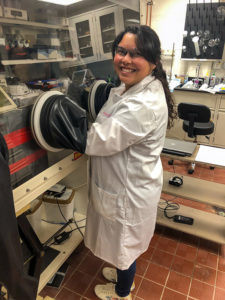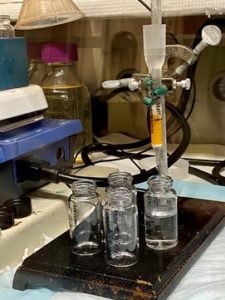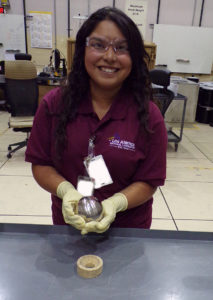The presence of plutonium in the nuclear fuel that was previously used in a nuclear power plant is a concern that calls for safeguards monitoring. In addition, the Neptunium-237 present in this used nuclear fuel is also of strategic importance and represents a safeguards concern, especially for those countries that reprocess and recycle plutonium. The concern comes from the process by which the valuable uranium and plutonium are separated from the used fuel, leaving the neptunium to be part of the high-level radioactive waste, which is currently not subject to safeguards monitoring.

Mariah Ramirez, a nuclear engineering graduate student working with the Center for Nuclear Security Science and Policy Initiatives (NSSPI), is conducting a technical study with the objective of developing safeguards approaches for neptunium present in reprocessed high-level radioactive waste. Ramirez is working with NSSPI Director Dr. Sunil Chirayath and Dr. Charles “Cody” M. Folden, III of the Texas A&M University Department of Chemistry and the Cyclotron Institute on a project funded by the US Department of Energy’s National Nuclear Security Administration through the Nuclear Science and Security Consortium.
“The goal of the study,” said Ramirez, “Is to improve safeguarding measures concerning Neptunium-237. Neptunium-237 is a long-lived isotope, which is a hazardous material and a proliferation risk. This technical study can influence the policy and help improve safeguards and security processes for neptunium through detection and quantification of materials.”
She notes that this is critical since there are currently no safeguards methods under the International Atomic Energy Agency in place for Neptunium-237 and the growth of the separations technologies for reprocessing used nuclear fuel could pose a risk to proliferation.

The project employs both computational radiation transport simulations and bench-top radiochemical experimental methods to quantify and analyze neptunium contained in high-level radioactive waste from the reprocessing of used nuclear fuel.
Ramirez used the ORIGEN code to simulate the production of Neptunium-237 from one ton of various types of reactor fuels. She then compared these results with unique irradiated depleted and natural uranium samples irradiated in representative neutron spectra of a fast and thermal reactor respectively at the High Flux Isotope Reactor (HFIR) at Oak Ridge National Laboratory (ORNL) and at the Missouri University Research Reactor (MURR). Ramirez then analyzed these samples using inductively coupled plasma mass spectrometry (ICP-MS) to quantify the amount of Neptunium-237 in the irradiated samples by separating it using radiochemical methods and to draw conclusions about neptunium production in low-burnup fuels.
“Overall,” Ramirez explained, “The project contributes to the missions of NNSA in nuclear security and nonproliferation because it focuses on the characterization of special nuclear material.”
While at Texas A&M, Ramirez completed two summer internships with Los Alamos National Laboratory where her work focused on the evaluation of neptunium nuclear data and benchmark evaluation. She also traveled to nuclear facilities throughout Europe with NSSPI as a chosen student participant in the International Nuclear Facilities Experience.

According to Ramirez, “This experience gave me valuable knowledge of the nuclear sector and provided cultural information and views on nuclear for various locations across the world.”
Ramirez earned a Bachelor’s of Science in Physics, Radiation Option, from the University of Texas at Austin in 2017. She defended her thesis in February 2021 and plans to receive her Master’s degree from Texas A&M in May 2021. In 2020, Ramirez accepted a position with IB3 Global Solutions where she will work in the Test and Evaluations Division.